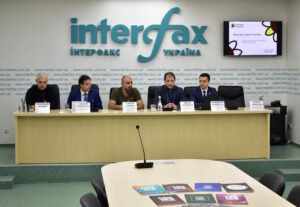
Raiffeisen Bank has opened its fourth underground service area in a shelter in Sumy.
“This is our contribution to ensuring that financial stability remains accessible even in the most difficult conditions,” Artem Nidzelsky, the bank’s retail banking director, was quoted as saying in a press release on Friday.
The underground branch is located in the seventh branch in Sumy at 1 Pokrovska Street.
This is the second such branch in Sumy. Earlier, similar branches of Raiffeisen Bank were opened in Kharkiv and Dnipro. Residents of Sumy can receive a full range of banking services.
According to the National Bank of Ukraine, at the beginning of the year, Raiffeisen Bank ranked 4th (UAH 238.9 billion) among 61 banks in the country in terms of total assets. The financial institution’s net profit as of that date amounted to UAH 222.3 billion.

On April 26, 2025, Uzhhorod will host the largest medical event in Ukraine – the Breast Weekend 2.0 conference, which will bring together industry leaders to share experiences, discuss modern techniques and the latest approaches in the field of aesthetic and oncoplastic mammoplasty. The conference is organized by Lita Plus Plastic Surgery Clinic.
The event will bring together more than 200 leading plastic surgeons, oncologists, cosmetologists, dermatologists and reconstructive surgeons to discuss topical issues of mammoplasty and at the same time support the Armed Forces of Ukraine.
A separate part of the conference will be a special panel devoted to complex cases of recovery of people who were seriously injured during the war. It will be presented by Oleksandr Turkevych, co-founder of the Neopalymi charity project, an initiative that brings together doctors to help combat victims, including in the treatment of scars, burns, and severe injuries.
The main mission is medicine for victory
In addition to its scientific value, the conference has a key charitable goal: all funds raised will be used to support the Armed Forces of Ukraine.
During the gala dinner that will take place after the conference, an additional fundraiser will be held to help the Ukrainian military.
About theorganizer: Lita Plus Clinic is a center for plastic surgery and aesthetic medicine that has already organized three charity conferences since the beginning of the full-scale invasion and purchased more than 10 vehicles for the military with the proceeds from previous events.
Program and key topics of the conference:
Speakers:
Serhiy Derbak , founder and head of Lita Plus clinic; Ruslan Humennyi , founder and plastic surgeon of PlastArt clinics; Vasyl Khrapach , MD, professor of the Department of Surgery at Bogomolets National Medical University; Yevhen Simulik , head of the Department of Microvascular, Plastic and Reconstructive Surgery at the National Center of Surgery and Transplantation named after O.O. Shalimov; Sergiy Romanyuk, Head of the Surgical Department of the Artmedium Clinic, Doctor of the highest category; Denys Pominchuk , Founder of the VERUM EXPERT Clinic; Andriy Zhyhulin , Head and Founder of the Mammology Center at the LISOD Israeli Oncology Hospital; Bohdan Shevnya , Director of Altamedica Medical Center LLC; Oleg Savenkov , Head of the Department of Plastic and Reconstructive Surgery at the Garvis Clinic; Artem Fedosov , Head of the Mammology Center at the Innovation Clinic; Oleksandr Karpinsky, surgeon at the Lita Plus Clinic; Ihor Drobner, oncologist and mammologist at the Khmelnytsky Regional Anti-Tumor Center; Tetiana Shevchuk, oncologist and mammologist at the VERUM EXPERT Medical Center; Sergiy Chuklin, oncologist and mammologist at St. Paraskeva Medical Center; Dmytro Bukhteev, oncologist and mammologist at the Center for Mammology at LISOD Israeli Oncology Hospital; Dmytro Mozhayev, oncologist, plastic surgeon at the Harvis Clinic and Medical Plaza, etc.
Conference partners: Motiva, Polytech Ukraine, Mentor Optimum Ukraine, Mentor Askmed, Vaser, CareForm.
Media partners: General media partner – Interfax Ukraine news agency; TV partner – Inter TV channel, Pryamyy TV channel.
With the support of associations – UPRADAS, ESSA.
Date: April 26, 2025
Location: Uzhhorod, hotel complex “Derenivska Kupil”
Start time: 08:00.
Online registration, agenda and other information are available on the website: https://livesurgery-transcarpathian.com
Media accreditation: +38 095 123 28 83, pr@litaplus.com (contact person: Kira Skrypnyk).
Interfax-Ukraine is a media partner
Source: https://interfax.com.ua/news/press-release/1065096.html

A meeting of the Capital Region discussion club was held at the press center of the Interfax-Ukraine news agency to discuss the vision of Ukraine’s victory and present the TOP-100 Most Influential People 2024 project.

During the meeting, the results of a sociological survey conducted by Active Group were presented, which showed that the idea of victory is transforming. The club members discussed the mood of Ukrainians and residents of Kyiv region, in particular in the context of the third year of full-scale war. Key issues included assessing the performance of local authorities, what people are willing to do to win, what victory means to them (return of borders, surrender of the enemy or ceasefire), and what hopes and fears people have for the so-called post-war day.
“Studies show that Ukrainians expect the war to continue for at least another six months. Amid talks of a truce after November 2024, the number of people willing to negotiate with Russia without conditions as soon as possible is falling, while at the same time, people’s desire to negotiate is growing, provided that the fighting stops completely. According to respondents, the Armed Forces are responsible for the success of the counteroffensive and defense, while international partners and allies and the President are responsible for the failure,” said Andriy Yeremenko, head of the sociological company Active Group.
Oleh Ivanenko, a member of the Kyiv regional council, said there are two ways to end the war quickly. The first, in his opinion, lies in the plane of Ukrainian politics, the second in American politics.
“The American option is the George Washington, the largest aircraft carrier, entering the Black Sea, and the war ends. The Ukrainian option is to declare a state of war. And then we will have no problems with demobilization, mobilization, because all MPs, officials, and the presidential administration are going to war,” he emphasized.
Oleksandr Magdych, a soldier of the Armed Forces of Ukraine and head of the Bila Tserkva Volunteer Corps, added that to achieve peace and victory, a general mobilization of the economy and citizens is needed, as well as a law on demobilization and rotation for the military.
“The unity of our society, our work to defend our country, starting with volunteers, soldiers, the government, the opposition – everyone is working for the result. Everyone wants the war to end on Ukrainian terms as soon as possible. This is very important, and my communication with our citizens confirms this. We communicate in different regions, on the contact lines with soldiers and volunteers of the volunteer battalion,” said Volodymyr Kreidenko, MP, Deputy Chairman of the Verkhovna Rada Committee on Transport.
Serhiy Guliyev, a member of the Vyshneve City Council and entrepreneur, said that the Safe Region community on Viber and Telegram, which he runs, already has more than half a million members from 41 countries.
“When the full-scale invasion began, the Sergey Guliyev Foundation was created, which is now recognized as the most powerful. I am pleased that a large percentage of the efforts to win are made by volunteers. We have been working around the clock for three years now. We have raised and sent hundreds of millions of hryvnias and thousands of trucks with aid to the frontline,” added Guliyev.
The discussion club also presented the project “TOP 100 Most Influential People of 2024”. The rating includes representatives of government, business, culture, science, and the public.
The top ten are Ruslan Kravchenko, former head of the Kyiv Regional Military Administration and head of the State Tax Service of Ukraine; Andriy Yermak, head of the Office of the President of Ukraine; Oleksiy Kuleba, Vice Prime Minister for Reconstruction of Ukraine and Minister of Community and Territorial Development, former deputy head of the Office of the President of Ukraine; Yaroslav Dobriansky, acting head of the Kyiv Regional Council; Oleh Tatarov, deputy head of the Office of the President of Ukraine; Anatoliy Shchadylo, head of the Main Department of the National Police in Kyiv Region; and Anatoliy Shchadylo, former deputy head of the National Police in Kyiv.
According to the authors of the rating, they do not focus only on positions. The main thing for them is the real impact of a person on the region, his or her contribution to the development of Kyiv region, initiatives and actions that change the life of the community.
The project “TOP-100 Most Influential People” has been implemented since 2017 by the creative team of the Moya Kyivshchyna News Agency and the editorial board of the independent newspaper Slovo i Dilo with the participation of experts from the Institute of Ukrainian Politics.
The rating is based on information and analytical research on the socio-political situation in the region. The publication is available both in print and online on the project’s website: https://top-100.kyiv.ua.
The Discussion Club is organized by the Moya Kyivshchyna News Agency, the Institute of Ukrainian Politics, and the sociological company Active Group. It brings together experts, politicians, MPs, academics, military and public figures.

At a meeting on Friday, April 18, the Cabinet of Ministers of Ukraine allocated a subvention of UAH 829 million. 245,663 thousand UAH for the construction of shelters in general secondary education institutions, said Taras Melnychuk, a representative of the Cabinet of Ministers in the Verkhovna Rada, in a telegram channel.
According to Melnychuk, the funds will be transferred from the state budget to local budgets for the implementation of a public investment project to equip safe conditions in general secondary education institutions, including military (naval, military sports) lyceums and lyceums with enhanced military and physical training, in 2025.

The state-owned Ukrgasbank (Kyiv) has put up for sale via the OpenMarket platform (SE SETAM of the Ministry of Justice) an administrative and production complex at 2-b Kurenivska Street in Obolon district of Kyiv with a starting price of UAH 240.2 million.
According to the press service of SETAM, the lot consists of an administrative building (4.8 thousand square meters), a brick garage (49.8 square meters) and warehouse buildings (15.9 thousand square meters in total). The total area of the complex is 20.9 thousand square meters.
It is noted that the components of the complex are under five arrests in criminal proceedings, and there is a dispute over the ownership. Other restrictions include the bank’s right to use utilities, the absence of contracts for the supply of utilities, including electricity, gas, and water.
The auction based on the Dutch model is scheduled for April 22.
According to the National Bank of Ukraine, Ukrgasbank was ranked fifth in terms of assets (UAH 213.72 billion) among 61 banks at the beginning of this year.

The Interdepartmental Commission on International Trade (ICIT) imposed a final anti-dumping duty of 35.7% on imports of household matches to Ukraine on April 16.
According to the ICIT’s announcement in the Uryadovyi Kurier newspaper on Friday, the decision will enter into force 30 days after the date of publication of the announcement.
The ICIT reminds that the anti-dumping investigation was initiated by the decision of April 12 against imports of matches from India and Pakistan at the complaint of Ukrainian Match Factory LLC, which has a share of more than 50% in the total production of matches in Ukraine.
At the same time, it was found that during the investigation period (April 1, 2023 – March 31, 2024), imports of matches from India were carried out at dumping prices, while there were no imports from Pakistan.
The ICIT found that during the study period (January 1, 2021 – March 31, 2024), the volume of dumped imports decreased by 47.3% in absolute terms, while increasing by 27.8% in relation to the total production of the product in Ukraine and by 26.4% in relation to consumption.
In addition, the national producer’s production volumes decreased by 58.7%, the level of production capacity utilization by 58.7%, domestic sales by 58.1%, financial result from domestic sales in dollar terms by 229.4%, in hryvnia terms by 275.3%, and profitability from domestic sales by 390.4%, which was negative.
The number of production workers also decreased by 2.4%, wages by 32.1%, labor productivity by 57.7%, investment by 100%, and warehouse balances increased by 134.1%.
The Commission found that the Republic of India has a significant export potential, which indicates the likelihood of a significant increase in the volume of dumped imports of matches from this country in the future.
The anti-dumping measures are applied to matches, except for pyrotechnic products of heading 3604, classified under code 3605 00 00 00 according to the Ukrainian Classification of Goods for Foreign Economic Activity.
Ukrainian Match Factory LLC was founded in 1995, with production facilities located in Rivne region. The design capacity of the factory is 630 million boxes of matches per year. The products are supplied to all regions of Ukraine and abroad.
According to opendatabot, in 2024, the factory suffered a loss of almost UAH 26 million (3% more than a year earlier), while net income increased by 9.7% to UAH 175.2 million. At the same time, in 2022, it had a profit of UAH 38 million and revenue of UAH 373.5 million.
The founder of the company is listed as British Paxstone Limited, and the ultimate beneficiary is Maria Fursina from Kyiv.